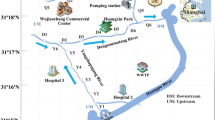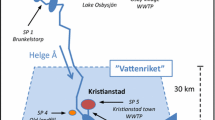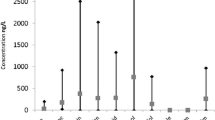Abstract
In the current study, 43 pharmaceuticals and 18 transformation products were studied in the river Meuse at the Belgian-Dutch border and four tributaries of the river Meuse in the southern part of the Netherlands. The tributaries originate from Belgian, Dutch and mixed Dutch and Belgian catchments. In total, 23 pharmaceuticals and 13 transformation products were observed in samples of river water collected from these rivers. Observed summed concentrations of pharmaceuticals and transformation products in river water ranged from 3.5 to 37.8 μg/L. Metformin and its transformation product guanylurea contributed with 53 to 80 % to this concentration, illustrating its importance on a mass basis. Data on the flow rate of different rivers and demographics of the catchments enabled us to calculate daily per capita loads of pharmaceuticals and transformation products. These loads were linked to sales data of pharmaceuticals in the catchment. Simple mass balance modelling accounting for human excretion and removal by sewage treatment plants revealed that sales could predict actual loads within a factor of 3 for most pharmaceuticals. Rivers that originated from Belgian and mixed Dutch and Belgian catchments revealed significantly higher per capita loads of pharmaceuticals (16.0 ± 2.3 and 15.7 ± 2.1 mg/inhabitant/day, respectively) than the Dutch catchment (8.7 ± 1.8 mg/inhabitant/day). Furthermore, the guanylurea/metformin ratio was significantly lower in waters originating from Belgium (and France) than in those from the Netherlands, illustrating that sewage treatment in the Belgian catchment is less efficient in transforming metformin into guanylurea. In summary, the current study shows that consumption-based modelling is suitable to predict environmental loads and concentrations. Furthermore, different consumption patterns and wastewater treatment efficiency are clearly reflected in the occurrence and loads of pharmaceuticals in regional rivers.







Similar content being viewed by others
References
Alder AC, Schaffner C, Majewsky M, Klasmeier J, Fenner K (2010) Fate of β-blocker human pharmaceuticals in surface water: comparison of measured and simulated concentrations in the Glatt Valley Watershed, Switzerland. Water Res 44:936–948
Ardakani YH, Rouini RM (2009) Pharmacokinetic study of tramadol and its three metabolites in plasma, saliva and urine. DARU 17:245–255
Belgian Centre for Pharmacotherapeutic Information (Belgisch Centrum voor Farmacotherapeutische Informatie, BCFI) "Hypolipemiërende middelen" June 2014 (http://www.bcfi.be)
Boyjoo Y, Pareek VK, Ang M (2013) A review of greywater characteristics and treatment processes. Water Sci Technol 67:1403–1424
Carr RA, Foster RT, Lewanczuk RZ, Hamilton PG (1992) Pharmacokinetics of sotalol enantiomers in humans. J Clin Pharmacol 32:1105–1109
Castiglioni S, Fanelli R, Calamari D, Bagnati R, Zuccato E (2004) Methodological approaches for studying pharmaceuticals in the environment by comparing predicted and measured concentrations in River Po, Italy. Regul Toxicol Pharmacol 39:25–32
Castiglioni S, Bagnati R, Fanelli R, Pomati F, Calamari D, Zuccato E (2006) Removal of pharmaceuticals in sewage treatment plants in Italy. Environ Sci Technol 40:357–363
Chitil L, Sticha M, Matouskova O, Perlik F, Slanar O (2009) Enantiomeric determination of tramadol and O-desmethyltramadol in human urine by gas chromatography-mass spectrometry. J Chromatogr B 877:1937–1942
Clara M, Strenn B, Kreuzinger N (2004) Carbamazepine as a possible anthropogenic marker in the aquatic environment: investigations on the behaviour of Carbamazepine in wastewater treatment and during groundwater infiltration. Water Res 38:947–954
de Jongh CM, Kooij PJF, de Voogt P, ter Laak TL (2012) Screening and human health risk assessment of pharmaceuticals and their transformation products in Dutch surface waters and drinking water. Sci Total Environ 427–428:70–77
de Voogt P, Janex-Habibi M-L, Sacher F, Puijker LM, Mons M (2009) Development of a common priority list of pharmaceuticals relevant for the water cycle. Water Sci Technol 59:39–46
Directorate General Statistics and Economic Information (DGSEI) "Statistics Belgium" December 2013. (http://statbel.fgov.be/)
Dix KJ, Coleman DP, Jeffcoat AR (1999) Comparative metabolism and disposition of gemfibrozil in male and female Sprague-Dawley rats and Syrian golden hamsters. Drug Metab Dispos 27:138–146
Eichelbaum M, Tomson T, Tybring G, Bertilsson L (1985) Carbamazepine metabolism in man. Induction and pharmacogenetic aspects. Clin Pharmacokinet 10:80–90
Escher BI, Fenner K (2011) Recent advances in environmental risk assessment of transformation products. Environ Sci Technol 45:3835–3847
European Medicines Agency (1997) Trimethoprim. Summary Report (2). European Agency for the Evaluation of Medicinal Products, London, p 10
European Medicines Agency (1998) Lincomycin—summary report. European Medicines Agency, London, p 10
Grubb NG, Rudy DW, Brater DC, Hall SD (1999) Stereoselective pharmacokinetics of ketoprofen and ketoprofen glucuronide in end-stage renal disease: evidence for a 'futile cycle' of elimination. Br J Clin Pharmacol 48:494–500
Heberer T (2002) Occurrence, fate, and removal of pharmaceutical residues in the aquatic environment: a review of recent research data. Toxicol Lett 131:5–17
Howell SR, Husbands GEM, Scatina JA, Sisenwine SF (1993) Metabolic disposition of 14C-venlafaxine in mouse, rat, dog, rhesus monkey and man. Xenobiotica 23:349–359
Kugathas S, Williams RJ, Sumpter JP (2012) Prediction of environmental concentrations of glucocorticoids: the River Thames, UK, as an example. Environ Int 40:15–23
Lamp KC, Freeman CD, Klutman NE, Lacy MK (1999) Pharmacokinetics and pharmacodynamics of the nitroimidazole antimicrobials. Clin Pharmacokinet 36:353–373
Larsson DGJ, de Pedro C, Paxeus N (2007) Effluent from drug manufactures contains extremely high levels of pharmaceuticals. J Hazard Mater 148:751–755
Liebig M, Moltmann JF, Knacker T (2006) Evaluation of measured and predicted environmental concentrations of selected human pharmaceuticals and personal care products. Environ Sci Pollut Res 13:110–119
Lienert J, Gudel K, Escher BI (2007) Screening method for ecotoxicological hazard assessment of 42 pharmaceuticals considering human metabolism and excretory routes. Environ Sci Technol 41:4471–4478
Lintz W, Erlacin S, Frankus E, Uragg H (1981) Biotransformation of tramadol in man and animal. Metab Tramadol Mensch Tier 31:1932–1943
Mezcua M, Malato O, Garcia-Reyes JF, Molina-Diaz A, Fernandez-Alba AR (2009) Accurate-mass databases for comprehensive screening of pesticide residues in food by fast liquid chromatography time-of-flight mass spectrometry. Anal Chem 81:913–929
Miege C, Choubert JM, Ribeiro L, Coquery M (2009) Fate of pharmaceuticals and personal care products in wastewater treatment plants - conception of a database and first results. Environ Pollut 157:1721–1726
Monteiro SC, Boxall ABA (2010) Occurence and fate of human pharmaceuticals in the environment. Rev Environ Contam Toxicol 202:53–154
Mossialos E, Mrazek M, Walley T (2004) regulating pharmaceuticals in Europe: striving for efficiency, equity and quality. WHO on behalf of the European Observatory on Health Systems and Policies, Cornwall, p 395
Onesios KM, Yu JT, Bouwer EJ (2009) Biodegradation and removal of pharmaceuticals and personal care products in treatment systems: a review. Biodegradation 20:441–466
Oosterhuis M, Sacher F, ter Laak TL (2013) Prediction of concentration levels of metformin and other high consumption pharmaceuticals in wastewater and regional surface water based on sales data. Sci Total Environ 442:380–388
Pomiès M, Choubert JM, Wisniewski C, Coquery M (2013) Modelling of micropollutant removal in biological wastewater treatments: a review. Sci Total Environ 443:733–748
Prescott LF (1980) Kinetics and metabolism of paracetamol and phenacetin. Br J Clin Pharmacol 10:291S–298S
Radjenovic J, Petrovic M, Barceló D (2007) Analysis of pharmaceuticals in wastewater and removal using a membrane bioreactor. Anal Bioanal Chem 387:1365–1377
RIWA Maas (2009) Stroomgebiedsbeheersplan voor het internationale district van de Maas - Overkoepelend deel. RIWA Maas, Liege
Roig B (2010) Pharmaceuticals in the environment - current knowledge and need assessment to reduce presence and impact. IWA, London, p 198
Rosal R, Rodriguez A, Perdigon-Melon JA, Petre A, Garcia-Calvo E, Gomez MJ, Aguera A, Fernandez-Alba AR (2010) Occurrence of emerging pollutants in urban wastewater and their removal through biological treatment followed by ozonation. Water Res 44:578–588
Rúa-Gómez PC, Püttmann W (2012) Occurrence and removal of lidocaine, tramadol, venlafaxine, and their metabolites in German wastewater treatment plants. Environ Sci Pollut Res 19:689–699
Scheurer M, Sacher F, Brauch H-J (2009) Occurence of the antidiabetic drug metformin in sewage and surface waters in Germany. J Environ Monit 11:1608–1613
Scheurer M, Michel A, Brauch HJ, Ruck W, Sacher F (2012) Occurrence and fate of the antidiabetic drug metformin and its metabolite guanylurea in the environment and during drinking water treatment. Water Res 46:4790–4802
SPGE (2006) PASH Plan dássainissement par sous-bassin hydrographique; sous-bassin de la Meuse Aval. Société Publique de Geistion de l'Eau
Sui Q, Huang J, Deng S, Chen W, Yu G (2011) Seasonal variation in the occurrence and removal of pharmaceuticals and personal care products in different biological wastewater treatment processes. Environ Sci Technol 45:3341–3348
ter Laak TL, Van der Aa M, Stoks P, Houtman C, van Wezel AP (2010) Relating environmental concentrations of pharmaceuticals to consumption: a mass balance approach for the river Rhine. Environ Int 36:403–409
Tu ZG, Zhao LL (1995) Metoprolol α-hydroxylation capacity in 96 Chinese Han volunteers. Acta Pharmacol Sin 16:325–329
van Batenburg-Eddes T, van den Berg-Jeths A, van der Veen AA, Verheij RA, de Neeling A (2002) Consumption in the Netherlands, regional variations in consumption of pharmaceuticals. "Slikken in Nederland. Regionale variaties in geneesmiddelengebruik". RIVM, Bilthoven, p 76
Van den Berg Jeths A, Van Batenburg-Eddes T (2003) The Netherlands swallows differently. Regional variations in cost and usage of medicines. Pharm Weekbl 138:840–844
Van Loenen AC (2008) Farmacotherapeutisch Kompas. CVZ
Vergouwen AA, Pieters BJ, Kools S (2011) Inventarisatie van emissie van geneesmiddelen uit zorginstellingen. ZORG, Deel C. STOWA, Amersfoort
Verlicchi P, Al Aukidy M, Zambello E (2012) Occurrence of pharmaceutical compounds in urban wastewater: removal, mass load and environmental risk after a secondary treatment-a review. Sci Total Environ 429:123–155
Watkinson AJ, Murby EJ, Costanzo SD (2007) Removal of antibiotics in conventional and advanced wastewater treatment: implications for environmental discharge and wastewater recycling. Water Res 41:4164–4176
Wick A, Fink G, Joss A, Siegrist H, Ternes TA (2009) Fate of beta blockers and psycho-active drugs in conventional wastewater treatment. Water Res 43:1060–1074
Acknowledgments
This work was funded by Waterleiding Maatschappij Limburg (WML), Roer and Overmaas Regional Water Authority, Peel and Maasvallei Regional Water Authority, the Waterschapsbedrijf, the joint research program of the Dutch drinking water companies (BTO) and Stichting Toegepast Onderzoek Waterbeheer (STOWA). The authors like to thank Meindert de Graaf for sampling and Rosa Sjerps for designing Fig. 1. Furthermore, Peter van Diepenbeek, Leo Puijkerand the rest of the “Limburg Consortium” are acknowledged for their constructive comments during the project. Jan Dirk Kroon and Joos Tielemans are thanked for sharing their knowledge on the consumption, prescription and application of human pharmaceuticals, and Pim de Voogt, Annemieke Kolkman, Alette Langenhoff and Gertjan Zwolsman are thanked for constructive comments on the manuscript.
Author information
Authors and Affiliations
Corresponding author
Additional information
Responsible editor: Ester Heath
Electronic supplementary material
Below is the link to the electronic supplementary material.
ESM 1
(DOCX 63 kb)
Rights and permissions
About this article
Cite this article
ter Laak, T.L., Kooij, P.J.F., Tolkamp, H. et al. Different compositions of pharmaceuticals in Dutch and Belgian rivers explained by consumption patterns and treatment efficiency. Environ Sci Pollut Res 21, 12843–12855 (2014). https://doi.org/10.1007/s11356-014-3233-9
Received:
Accepted:
Published:
Issue Date:
DOI: https://doi.org/10.1007/s11356-014-3233-9




